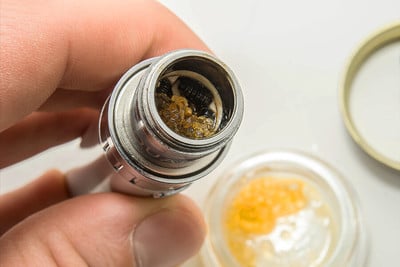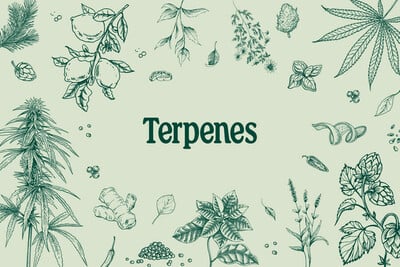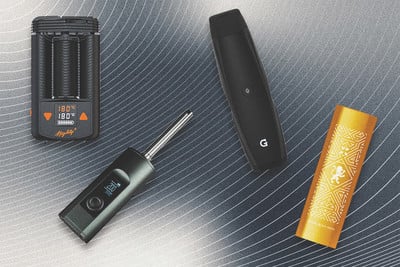.

Ideal Temperatures For Vaporizing Cannabis
Temperature settings give users more control over their vaporizing experience. Higher temps result in more potent highs, whilst lower ones result in gentle and functional effects.
Contents:
- Why the right vaping temperature for weed is essential
- The science of vaporizing cannabinoids and terpenes
- What’s the best temperature to vape weed?
- Choosing the right vaporizer for your needs
- How to find the best temp to vape weed
- How to reuse vaporized cannabis buds
- Wrapping things up: finding the best temp to vape weed
Key Points
- Discover how different vaporizer temperatures affect flavor, potency, and effects.
- Learn the boiling points of THC, CBD, and terpenes to optimise your experience.
- Browse some of the best vaporizers for experimenting with weed temps.
- Discover which temperature settings are best for vaping dry herb and concentrates.
- Find out how to reuse vaporized cannabis buds creatively.
Vaping weed opens up a whole new world of possibilities compared to smoking. Discover the best temperature for vaping weed below, and learn how to customise your marijuana experience to match your preferences for flavor and effects.

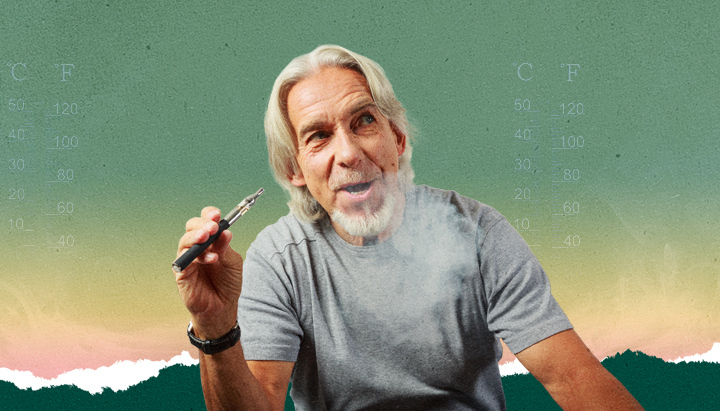
Why the Right Vaping Temperature for Weed Is Essential
By using a weed vaporizer with adjustable temperature settings, you can target particular chemicals and tweak the effects and flavors you’ll experience as a result. Aside from targeting THC's boiling point, you can also do so for different terpenes and other cannabis constituents. Eventually, you’ll find the perfect temperature that works for you.
The Science of Vaporizing Cannabinoids and Terpenes
You can look at smoking weed like using a sledgehammer and vaping weed like using a sniper rifle. You see, cannabis buds contain hundreds of different cannabinoids and terpenes, from THC and CBD to pinene and myrcene. Each of these molecules has its own individual boiling point.
When smoking cannabis, you’re essentially blitzing every chemical at the same time. Sure, this works, but it can take away something special from the experience. Because smoking combusts cannabis molecules at such a high temperature, you end up degrading many terpenes before you even inhale them, reducing the flavors and effects of your favorite strains.
Use a weed vaporizer, however, and you’ll have the freedom to customise every hit. That said, the boiling points of chemicals in cannabis vary drastically, with the boiling point of THC being just 105°C (221°F) and that of the flavonoid quercetin being 250°C (482°F).
The boiling points of all the major terpenes and cannabinoids in weed flowers sit between these two extremes. Therefore, the best temperature to vape weed depends on the exact constituents you want to target and enjoy.
How THC and CBD React to Vape Temps
THC and CBD both have very precise boiling points. It just so happens that they’re among the most sensitive to heat. So, what are the CBD and THC vaporization points? Check them out below:
- THC vaporization point: 105°C (221°F)
| THC | |
|---|---|
| CATEGORY | Cannabinoid |
| EFFECT | Euphoria and happiness |
| PSYCHOACTIVITY | Psychoactive |
| FLAVOR | Unflavoured |
| CATEGORY | EFFECT | PSYCHOACTIVITY | FLAVOR | |
| THC | Cannabinoid | Euphoria and happiness | Pyschoactive | Unflavoured |
- CBD vaporization point: 120°C (248°F)
| CBD | |
|---|---|
| CATEGORY | Cannabinoid |
| EFFECT | Antioxidant, neuroprotective |
| PSYCHOACTIVITY | Non-psychoactive |
| FLAVOR | Unflavoured |
| CATEGORY | EFFECT | PSYCHOACTIVITY | FLAVOR | |
| CBD | Cannabinoid | Antioxidant, neuroprotective | Non-psychoactive | Unflavoured |
Now, take this into consideration: the tip of a joint burns at around 900°C (1,652°F), combusting anything in its path. Not only does this degrade more volatile terpenes and cannabinoids before you even breathe them in, but it gives you almost no control over what you’re inhaling.
Vaporizers take a much more nuanced approach. By selecting a low-temperature setting, you can target both THC and CBD alongside more heat-sensitive terpenes. Not only will this result in a smoother hit, but you’ll preserve more terpenes and enjoy a more comprehensive flavor experience with each strain.
From here, you can further tinker with the temperature settings of your dry herb vaporizer to target other terpenes and cannabinoids with precision.
What’s the Best Temperature to Vape Weed?
It’s a good question, but it’s akin to asking somebody, “What’s the best weed strain?”. Simply put, the best dry herb temperature all comes down to personal preference, so you may need to experiment a little bit. A high-quality device will let you experiment with dry herb vape temps within 1°F increments, giving you complete control over the cannabinoids and terpenes you choose to target.
Some users may find that the best temperature is on the lower side, targeting mainly THC, CBD, and a few volatile terpenes. In contrast, others may enjoy setting their vape to a much higher temperature, enabling them to vaporize other novel cannabinoids as well as less-volatile terpenes and flavonoids.
Ultimately, the best heat to vape weed is the one you enjoy the most. Different strains also have different chemical compositions, so play around until you find the perfect sweet spot.
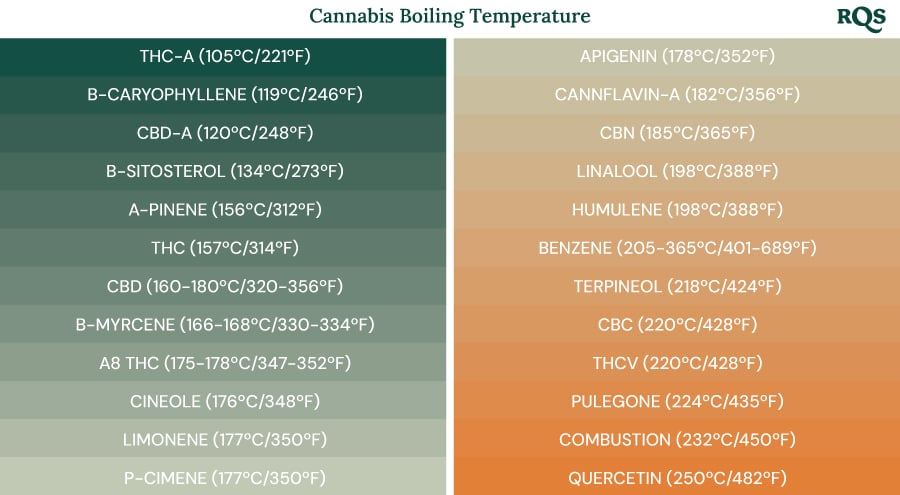
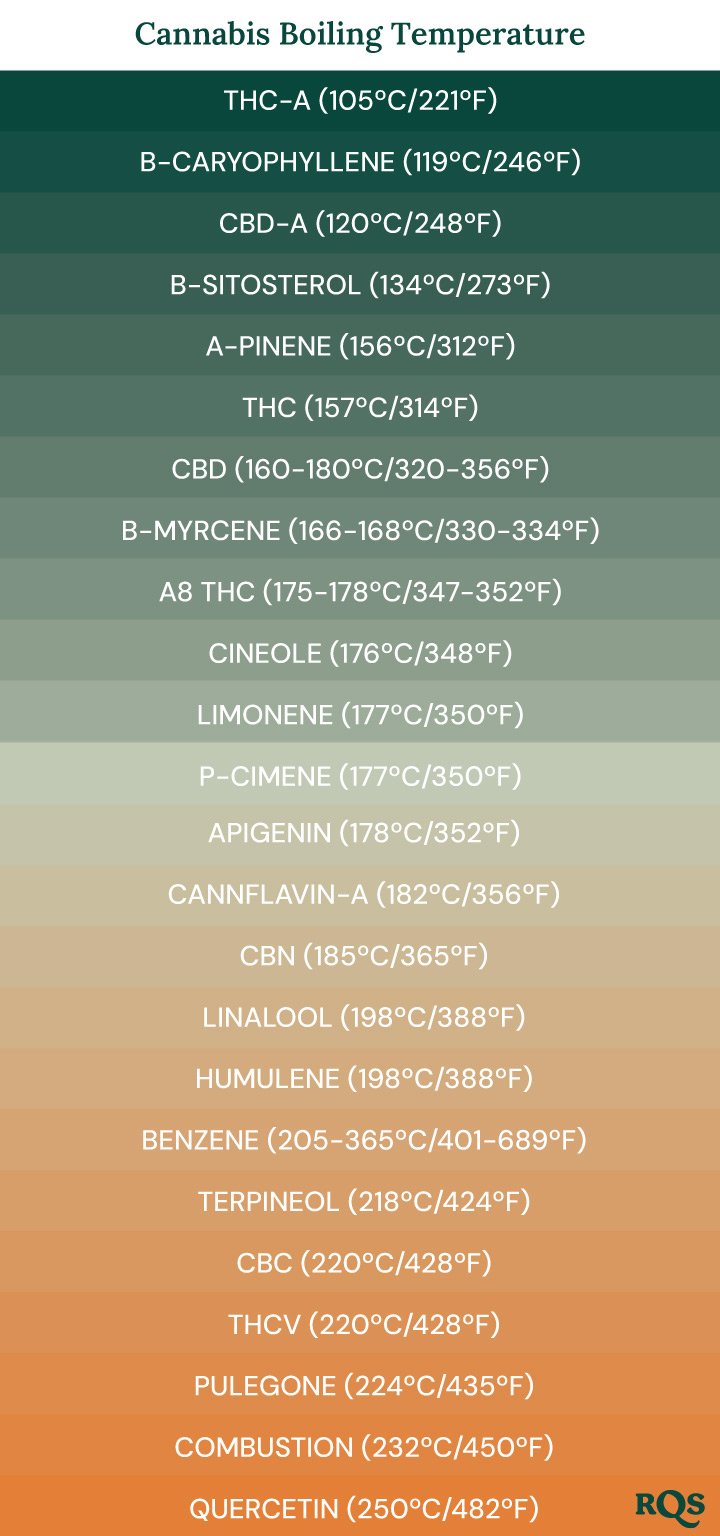
Below is a rough outline of the effects produced by each temperature bracket.
LOW: 119–159°C/246–318°F
• Caryophyllene: 119°C/246°F
Caryophyllene is a dominant terpene within most cannabis strains. The molecule is also referred to as a dietary cannabinoid due to its presence within food sources such as black pepper, and its action on the CB2 receptor. Caryophyllene may help to manage pain by reducing inflammation.
| CARYOPHYLLENE | |
|---|---|
| CATEGORY | Terpene |
| EFFECT | Reduce inflammation |
| PSYCHOACTIVITY | Non-psychoactive |
| FLAVOR | Spicy |
| STRAIN | Sweet ZZ |
| CATEGORY | EFFECT | PSYCHOACTIVITY | FLAVOR | STRAIN | |
| CARYOPHYLLENE | Terpene | Reduce inflammation | Non-psychoactive | Spicy | Sweet ZZ |
• β-sitosterol: 134°C/273°F
β-sitosterol is one of several flavonoids found within cannabis. The molecule has demonstrated anti-inflammatory activity[5].
| Β-SITOSTEROL | |
|---|---|
| CATEGORY | Flavonoid |
| EFFECT | Anti-inflammatory |
| PSYCHOACTIVITY | Non-psychoactive |
| FLAVOR | Unflavoured |
| CATEGORY | EFFECT | PSYCHOACTIVITY | FLAVOR | |
| Β-SITOSTEROL | Flavonoid | Anti-inflammatory | Non-psychoactive | Unflavoured |
• α-pinene: 156°C/312°F
α-pinene adds delicious tastes of pine and rosemary to this temperature bracket. The terpene is associated with anti-anxiety effects and may help to prevent the adverse effects of THC, such as short-term memory impairment. α-pinene may also synergise with THC to increase airflow to the lungs.
| A-PINENE | |
|---|---|
| CATEGORY | Terpene |
| EFFECT | Anti-anxiety |
| PSYCHOACTIVITY | Non-psychoactive |
| FLAVOR | Pine, Rosemary |
| STRAIN | Haze Berry |
| CATEGORY | EFFECT | PSYCHOACTIVITY | FLAVOR | STRAIN | |
| A-PINENE | Terpene | Anti-anxiety | Non-psychoactive | Pine, Rosemary | Haze Berry |
• THC: 157°C/314°F
THC is the main psychotropic component in cannabis. The cannabinoid penetrates the blood-brain barrier and activates CB1 receptors in the central nervous system. THC alters the firing pattern of neurons and catalyses an acute rise in the neurotransmitter dopamine. This results in euphoria, happiness, giggles, and increased appetite. High levels of THC can induce a profound altered state of consciousness that causes anxiety in some users.
| THC | |
|---|---|
| CATEGORY | Cannabinoid |
| EFFECT | Euphoria and happiness |
| PSYCHOACTIVITY | Psychoactive |
| FLAVOR | Unflavoured |
| STRAIN | Hulkberry |
| CATEGORY | EFFECT | PSYCHOACTIVITY | FLAVOR | STRAIN | |
| THC | Cannabinoid | Euphoria and happiness | Pyschoactive | Unflavoured | Hulkberry |
• CBD: 160–180°C/320–356°F
CBD induces a relaxing and calming effect, but it’s not psychoactive in the same sense at THC—it can’t get you high. Instead, CBD is known to counteract some of the effects of THC by temporarily blocking CB1 receptors. CBD is also believed to act via numerous other molecular pathways to decrease inflammation and impart antioxidant and neuroprotective effects.
| CBD | |
|---|---|
| CATEGORY | Cannabinoid |
| EFFECT | Antioxidant, neuroprotective |
| PSYCHOACTIVITY | Non-psychoactive |
| FLAVOR | Unflavoured |
| STRAIN | Solomatic CBD |
| CATEGORY | EFFECT | PSYCHOACTIVITY | FLAVOR | STRAIN | |
| CBD | Cannabinoid | Antioxidant, neuroprotective | Non-psychoactive | Unflavoured | Solomatic CBD |
LOW/MEDIUM: 160–180°C/320–392°F
Vaping within this temperature range invites some extremely interesting molecules to the party. If you’re vaping high-CBD flowers, this is the optimal range to release the molecule alongside key terpenes. If you’re vaping high-THC flowers, you’ll unleash a lot more terpenes at this temperature.
• Myrcene: 166–168°C/330–334°F
Myrcene is the most common terpene within cannabis, and it becomes available within this temperature bracket. The molecule provides tastes of earthiness, grapes, and spice. Myrcene exerts a slightly sedating effect and is the chemical behind the relaxing properties of most indica cultivars.
| MYRCENE | |
|---|---|
| CATEGORY | Terpene |
| EFFECT | Relaxing |
| PSYCHOACTIVITY | Non-psychoactive |
| FLAVOR | Grapes, spice |
| STRAIN | Dance World |
| CATEGORY | EFFECT | PSYCHOACTIVITY | FLAVOR | STRAIN | |
| MYRCENE | Terpene | Relaxing | Non-psychoactive | Grapes, spice | Dance World |
• Δ8-THC: 175–178°/347–352°F
Δ8-THC adds a subtle psychoactive kick to this temperature bracket. It’s an analogue of THC that binds to CB1 receptors to produce anti-nausea, anti-anxiety, appetite-stimulating, painkilling, and neuroprotective effects. However, Δ8-THC only occurs in cannabis in very small amounts. Additionally, it has a lower psychoactive potency than its more common counterpart.
| Δ8-THC | |
|---|---|
| CATEGORY | Cannabinoid |
| EFFECT | Anti-nausea |
| PSYCHOACTIVITY | Psychoactive |
| FLAVOR | Unflavoured |
| CATEGORY | EFFECT | PSYCHOACTIVITY | FLAVOR | |
| Δ8-THC | Cannabinoid | Anti-nausea | Psychoactive | Unflavoured |
• Cineole: 176°C/348°F
Cineole is a fascinating terpene. It’s one of the main components of eucalyptus, yet is quite rare in modern-day cannabis strains. The terpene has demonstrated[6] anti-viral, painkilling, anti-fungal, antibiotic, and anti-inflammatory effects. Cineole also increases cerebral blood flow.
| CINEOLE | |
|---|---|
| CATEGORY | Terpene |
| EFFECT | Anti-viral |
| PSYCHOACTIVITY | Non-psychoactive |
| FLAVOR | Eucalyptus |
| CATEGORY | EFFECT | PSYCHOACTIVITY | FLAVOR | |
| CINEOLE | Terpene | Anti-viral | Non-psychoactive | Eucalyptus |
• Limonene: 177°C/350°F
Limonene infuses cannabis vapor with hints of citrus. The molecule makes the effects of THC more cerebral and euphoric. In animal research[7], limonene reduced anxiety and boosted serotonin levels in the prefrontal cortex, as well as dopamine levels in the hippocampus.
| LIMONENE | |
|---|---|
| CATEGORY | Terpene |
| EFFECT | Boost dopamine |
| PSYCHOACTIVITY | Non-psychoactive |
| FLAVOR | Citrus |
| STRAIN | Green Gelato |
| CATEGORY | EFFECT | PSYCHOACTIVITY | FLAVOR | STRAIN | |
| LIMONENE | Terpene | Boost dopamine | Non-psychoactive | Citrus | Green Gelato |
• p-cymene: 177°C/350°F
p-cymene is found in cumin and thyme. It contributes a sweet and citrusy aroma, and has been shown in animal studies to display a sedating effect[9].
| P-CYMENE | |
|---|---|
| CATEGORY | Terpene |
| EFFECT | Sedative |
| PSYCHOACTIVITY | Non-psychoactive |
| FLAVOR | Sweet, citrus |
| STRAIN | Sour Diesel |
| CATEGORY | EFFECT | PSYCHOACTIVITY | FLAVOR | STRAIN | |
| P-CYMENE | Terpene | Sedative | Non-psychoactive | Sweet, citrus | Sour Diesel |
• Apigenin: 178°C/352°F
Apigenin is another flavonoid found in the cannabis plant. This molecule exerts anti-anxiety effects and is the key anxiolytic agent found in chamomile flowers. Impressively, it acts on the same receptors as benzodiazepines, yet doesn’t cause the side effects of amnesia or sedation.
| APIGENIN | |
|---|---|
| CATEGORY | Flavonoid |
| EFFECT | Anxyiolitic |
| PSYCHOACTIVITY | Non-psychoactive |
| FLAVOR | Chamomille |
| CATEGORY | EFFECT | PSYCHOACTIVITY | FLAVOR | |
| APIGENIN | Flavonoid | Anxyiolitic | Non-psychoactive | Chamomille |
MEDIUM/HIGH: 181–200°C/357–392°F
This temperature range adds further therapeutic properties to cannabis vapor. The addition of a particular cannabinoid also adds a sedating and relaxing edge.
• Cannflavin A: 182°C/356°F
Cannflavin A is a flavonoid found in larger quantities within cannabis leaves. The molecule possesses impressive anti-inflammatory[8] properties.
| CANNFLAVIN A | |
|---|---|
| CATEGORY | Flavonoid |
| EFFECT | Anti-inflammatory |
| PSYCHOACTIVITY | Non-psychoactive |
| FLAVOR | Nutty |
| STRAIN | OG Kush |
| CATEGORY | EFFECT | PSYCHOACTIVITY | FLAVOR | STRAIN | |
| CANNFLAVIN A | Flavonoid | Anti-inflammatory | Non-psychoactive | Nutty | OG Kush |
• CBN: 185°C/365°F
CBN (cannabinol) was the first cannabinoid isolated from cannabis. Unlike other cannabinoids, it’s not made in the plant via enzymatic reactions. Instead, CBN results from the degradation of THC. CBN will add an element of sedation to the high, alongside anti-inflammatory effects. CBN also shows promise as an anticonvulsant and may reduce the symptoms of psoriasis.
| CBN | |
|---|---|
| CATEGORY | Cannabinoid |
| EFFECT | Anticonvulsant |
| PSYCHOACTIVITY | Psychoactive |
| FLAVOR | Unflavoured |
| STRAIN | Royal AK |
| CATEGORY | EFFECT | PSYCHOACTIVITY | FLAVOR | STRAIN | |
| CBN | Cannabinoid | Anticonvulsant | Psychoactive | Unflavoured | Royal AK |
• Linalool: 198°C/388°F
Linalool adds a potent floral aroma to many cannabis cultivars, with hints of lavender and citrus. The terpene is responsible for several of the potential therapeutic properties of cannabis. The molecule possesses antidepressant, anti-anxiety, and immunopotentiating properties—it directly enhances several immune functions.
| LINALOOL | |
|---|---|
| CATEGORY | Terpene |
| EFFECT | Antidepressant |
| PSYCHOACTIVITY | Non-psychoactive |
| FLAVOR | Floral |
| STRAIN | Special Kush 1 |
| CATEGORY | EFFECT | PSYCHOACTIVITY | FLAVOR | STRAIN | |
| LINALOOL | Terpene | Antidepressant | Non-psychoactive | Floral | Special Kush 1 |
HIGH: 201°C+/393°F+
This is the high end of the temperature spectrum. Here, further beneficial cannabinoids and terpenes evaporate. However, things are starting to get hot. This is where vaping becomes more like smoking and some detrimental molecules turn into gases. Although this temperature range is thought to release all of the beneficial compounds within cannabis flowers, it’s a fine balance between optimal vaporization and releasing harmful chemicals.
• Benzene: 205–365°C/401–689°F
Unfortunately, the beneficial molecules in this temperature bracket come along with a hit of benzene. This carcinogen is one reason many cannabis users are abandoning smoking. Although benzene has a boiling point of 80°C, some vape models have been proven to eliminate the chemical up to temperatures of 200°C. So far, there’s no confirmed figure of the vaporization point of benzene in cannabis consumption. Some reports suggest the number could be as high as 365°C.
• Terpineol: 218°C/424°F
Terpineol provides a subtle scent of lilac and commonly appears in perfumes and cosmetics. The terpene has demonstrated multiple therapeutic[9] effects, including anti-malarial, antibiotic, antioxidant, and sedative properties.
| TERPINEOL | |
|---|---|
| CATEGORY | Terpene |
| EFFECT | Anti-malarial |
| PSYCHOACTIVITY | Non-psychoactive |
| FLAVOR | Lilac |
| CATEGORY | EFFECT | PSYCHOACTIVITY | FLAVOR | |
| TERPINEOL | Terpene | Anti-malarial | Non-psychoactive | Lilac |
• THCV: 220°C/428°F
THCV (tetrahydrocannabivarin) evaporates at higher temperatures. This cannabinoid is an analogue of THC and occurs in minor concentrations. However, cultivars high in the cannabinoid do exist. THCV works to activate and block CB1 receptors. The cannabinoid is associated with anticonvulsant properties[9] and has shown the ability to combat pain and inflammation. THCV may also assist with weight loss and fat metabolism.
| THCV | |
|---|---|
| CATEGORY | Cannabinoid |
| EFFECT | Combat pain |
| PSYCHOACTIVITY | Psychoactive |
| FLAVOR | Unflavoured |
| CATEGORY | EFFECT | PSYCHOACTIVITY | FLAVOR | |
| THCV | Cannabinoid | Combat pain | Psychoactive | Unflavoured |
• Pulegone: 224°C/435°F
Pulegone generates a pleasant odour of peppermint and camphor. Heating your vape to these temperatures might be worth it to access this terpene[10]. The molecule exerts memory-boosting and sedating effects. Some evidence also suggests that pulegone can combat fevers.
| PULEGONE | |
|---|---|
| CATEGORY | Terpene |
| EFFECT | Memory-boosting |
| PSYCHOACTIVITY | Non-psychoactive |
| FLAVOR | Peppermint |
| CATEGORY | EFFECT | PSYCHOACTIVITY | FLAVOR | |
| PULEGONE | Terpene | Memory-boosting | Non-psychoactive | Peppermint |
• Quercetin: 250°C/482°F
Quercetin is a cannabis flavonoid with an antioxidant[12] potency that rivals that of vitamin C. The molecule also possesses antiviral and antineoplastic effects.
| QUERCETIN | |
|---|---|
| CATEGORY | Flavonoid |
| EFFECT | Antiviral |
| PSYCHOACTIVITY | Non-psychoactive |
| FLAVOR | Bitter |
| CATEGORY | EFFECT | PSYCHOACTIVITY | FLAVOR | |
| QUERCETIN | Flavonoid | Antiviral | Non-psychoactive | Bitter |
Choosing the Right Vaporizer for Your Needs
Weed vaporizers not only come in all different shapes and sizes, but each model has a specific type of heating system. Moreover, some models are suited for dry herb while others are made for cannabis concentrates. Learn more about these distinctions below, followed by a list of some of the best vapes currently on the market.
-
Convection vs Conduction: Heating Methods Explained
When shopping around for your perfect vaporizer, you’ll come across both convection and conduction models. These vapes both successfully vaporize weed, but do so in different ways.
- Conduction vaporizers: This heating system places the heating element in direct contact with weed flowers. It offers faster heating times but also increases the risk of combustion when using high vape temps.
- Convection vaporizers: This system heats weed flowers indirectly using hot air currents, resulting in even heating and better flavor in the eyes of many users.
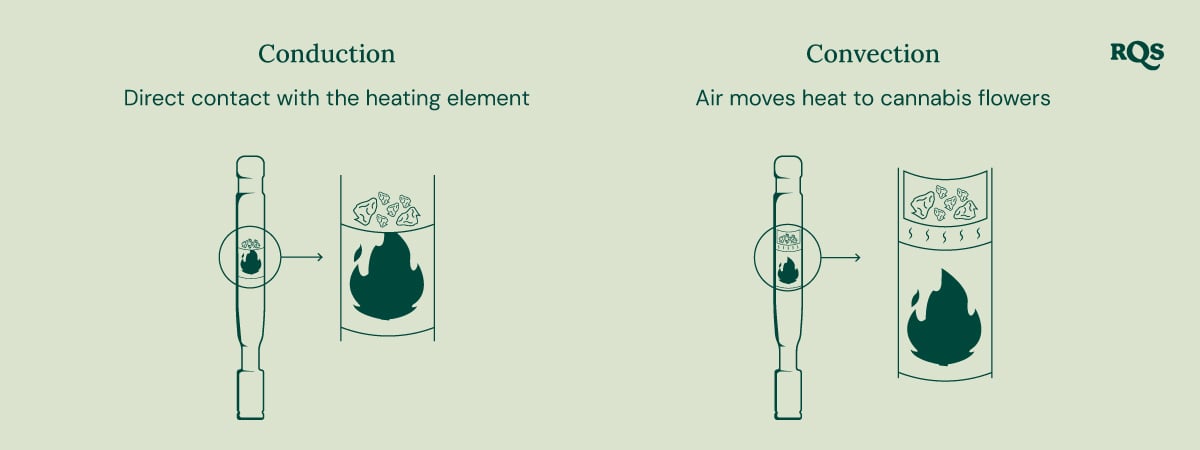
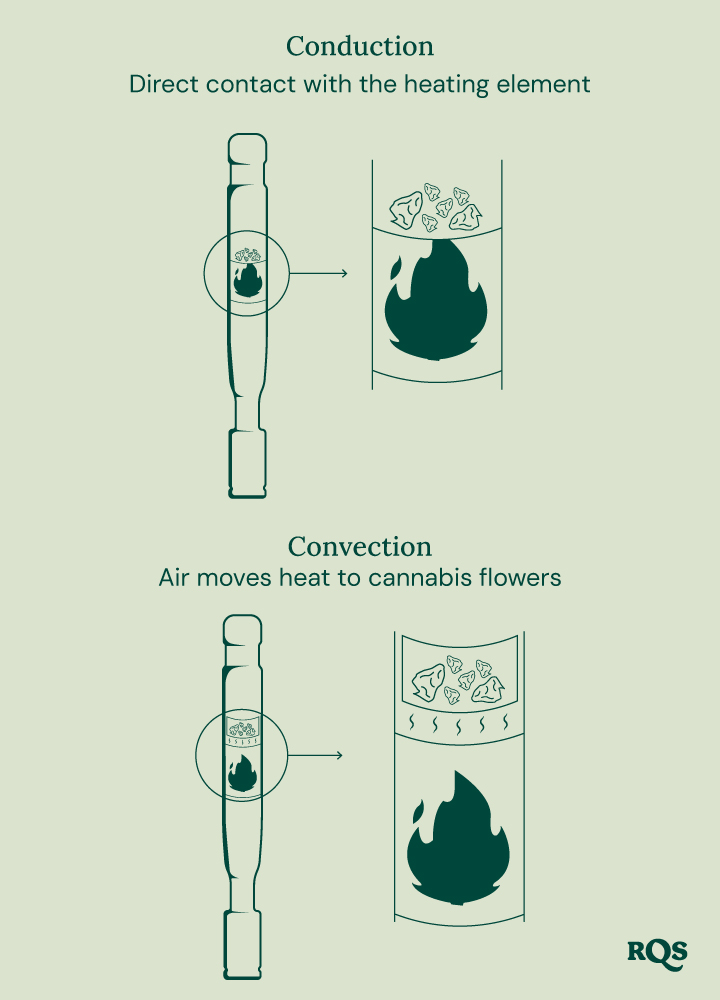
-
Hybrid Vaporizers: The Best of Both Worlds
As their name suggests, hybrid vaporizers feature heating systems that combine both convection and conduction technology. They’re among the best choices when looking to pinpoint your perfect cannabis vape temperature.
By using both conduction and convection, hybrid weed vapes offer precise temperature controls and pair fast heat-up times with thorough vaporization, allowing you to get the most out of every piece of bud.
-
Top Vaporizers for Dry Herb and Concentrates
So, which vape should you choose for the best overall vaping experience? We’re going to introduce you to some of the finest options below. But first, let’s quickly review the difference between dry herb and concentrates.
- Dry herb: This simply refers to dried and cured weed flowers. This product contains a wide variety of cannabis phytochemicals in varying concentrations depending on the strain.
- Concentrates: These products are extracts that provide high concentrations of specific cannabinoids and terpenes. Examples include wax, shatter, oil, and live resin.
Without further ado, check out some of the very best vapes for dry herb and concentrates below:
- G Pen Dash Vaporizer: The G Pen Dash Vaporizer features adjustable temperature settings, allowing you to tailor your experience. Whether you prefer light, flavorful hits or dense clouds, this portable vaporizer delivers smooth and consistent results.
- MIGHTY+: Created by Storz & Bickel, the MIGHTY+ ranks as one of the most popular dry herb vapes. The model boasts a speedy 60-second heat-up time, a hybrid heating system, and precise temp settings.
- PAX MINI: Small, sleek, and highly portable, the PAX MINI vaporizer combines an impressive battery life of 2.5 hours with a 22-second heat-up time. Capable of processing up to 0.25 g of dry herb, this vape makes the perfect companion for travelling.
- CRAFTY+: Another superb creation from Storz & Bickel, the CRAFTY+ offers precise temperature settings and great versatility. Simply insert a concentrate pad, and you can switch from dry herb to vaping your favorite concentrate products.
- Firefly 2+: Futuristic aesthetics meet simplicity in the Firefly 2+ vaporizer. Fire up both dry flowers and concentrates with this portable device that heats up in only three short seconds.
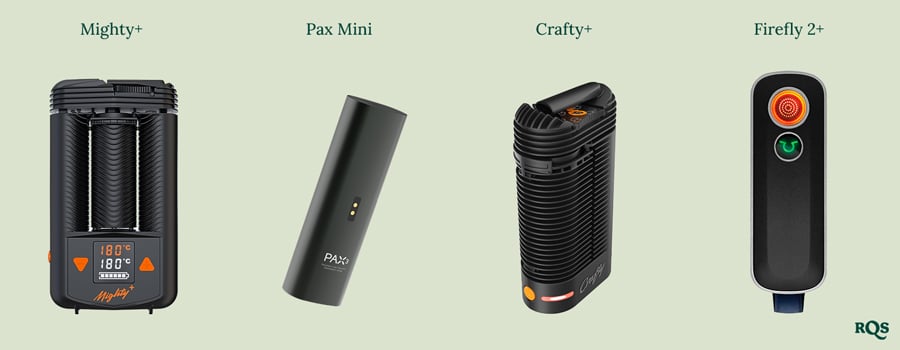
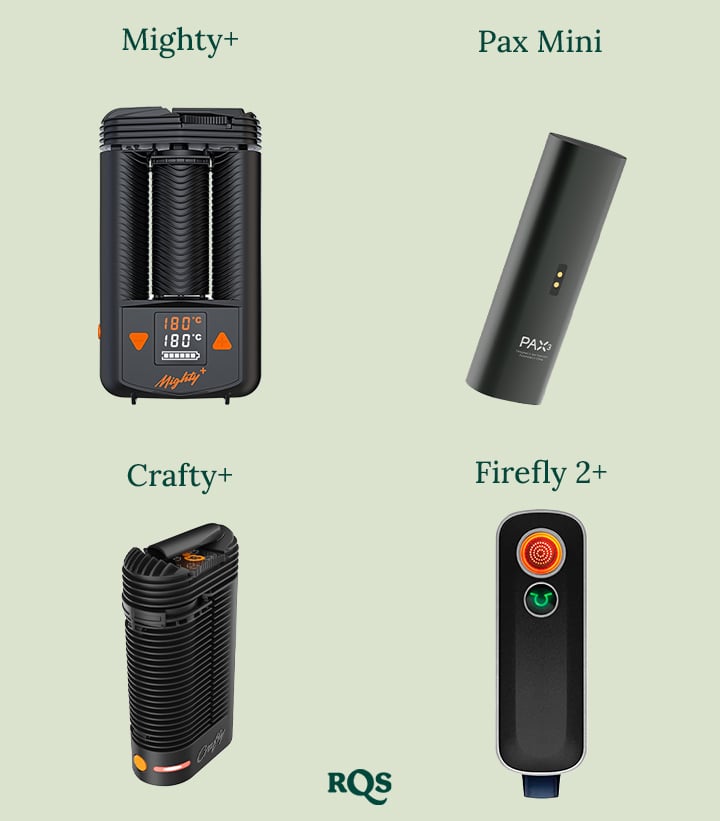
How to Find the Best Temp to Vape Weed
As mentioned, the best temperature for vaping weed is a subjective affair. So, in order to find your sweet spot, check out some of the tips below:
- Start low: Take a regimented approach. Start out using low-temperature settings around THC's boiling point. This will help you to get familiar with the most volatile terpenes within a strain while enjoying the high it has to offer.
- Increase slowly: Slowly increase the temperature by around 50°F (10°C) with each load of flower or concentrate. Moving through the temperature ranges slowly will gradually introduce new terpenes and help you identify the best temp to vape flower and concentrates.
- Explore different strains: Each strain contains a different terpene and cannabinoid profile. So, repeat the same process with each variety you vape, making note of the ideal temperature range for each. For example, try out Haze Berry and Pineapple Kush for fruity flavors, or Diesel Auto for gassy notes.
- Use quality flowers and concentrates: Aim to use high-quality products that are free from contaminants and properly cured and processed for the most flavorful experience.
How to Reuse Vaporized Cannabis Buds
Unlike combusting weed flowers, which leaves behind nothing but ash, vaped flowers are still viable for other uses. After vaping your weed at the best temperature, you can put your vaporized buds to use in the following ways:
- Make a tincture: Simply combine your plant material with high-proof alcohol to make a potent tincture!
- Edibles: You can substitute dried flower for vaped material to make a range of tasty edible products.
- Capsules: Forgo cooking and simply place your vaped material into capsules for an easy-to-make edible option.
- Coconut oil: Place your material in a slow cooker with some coconut oil for several hours. Strain the mixture through cheesecloth for a cannabinoid-infused coconut oil.
Wrapping Things Up: Finding the Best Temp to Vape Weed
The best temperature to vape weed depends on personal preference; there’s no universal “best.” The settings you use depend on the cannabinoids and terpenes you want to experience. The only true way to know the ideal temperature to vape at is to experiment.
Start low and gradually work up through the temperature ranges with strains you’re familiar with, unlocking new flavors and experiences until you find your phytochemical sweet spot.
Take the same approach with the new strains you try. Note down which strain works best at which temperature and you’ll have a little cache of data ready to refer to every time you fire up your vape.
Unlike smoking, vaping gives users surgical precision over their cannabis experience. Use this tech to make the most of your weed!


























